Reviews
We Parsed Artist Joe Zucker’s Witty Cult Opus, ‘100 Foot Long Piece,’ Panel by Panel
Zucker, who is now in his late 70s, made the work when he had just moved to New York from Minneapolis as a young artist.
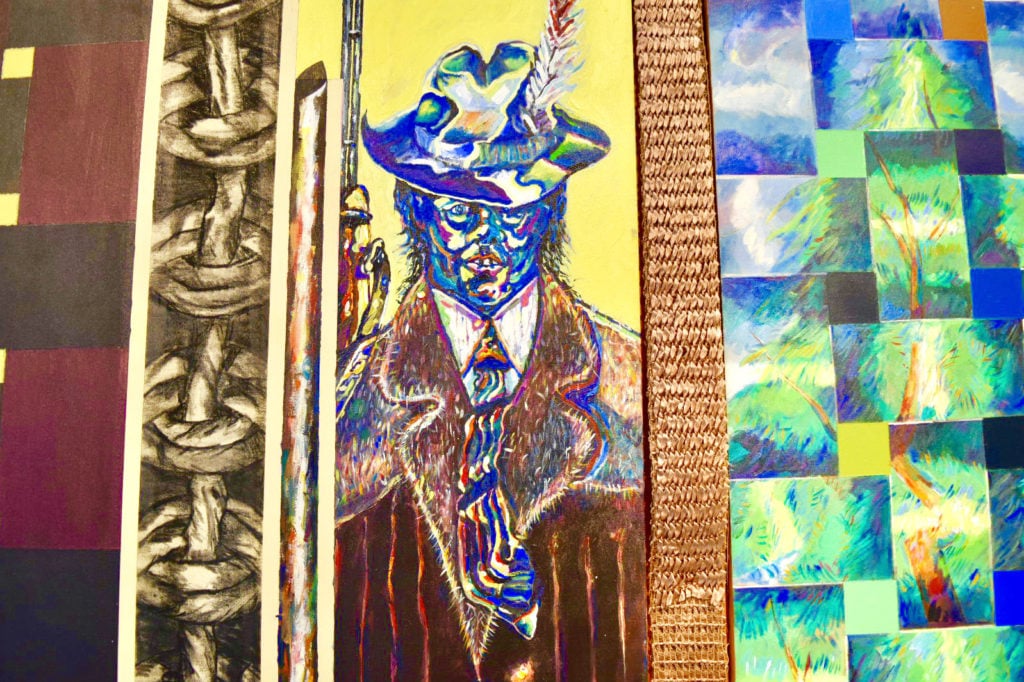
Zucker, who is now in his late 70s, made the work when he had just moved to New York from Minneapolis as a young artist.

Ben Davis

Joe Zucker’s 100-Foot-Long Piece is a great big painting with a cult following. Made a half century ago, in 1968-69, the multi-panel opus currently occupies one long wall at Marlborough in Chelsea, where you can get a sense of the funky, fractured sensibility that has given this unwieldy artwork its legend as a fan favorite for artists and aficionados.
Zucker is now 78, and certainly not a totally obscure figure. Among other achievements, he was part of the important “New Image Painting” show at the Whitney in 1978, alongside figures like Jennifer Bartlett, Neil Jenney, and Susan Rothenberg. He has shown his tough-to-categorize work steadily for decades. Still, there’s a sense that it is hard to know where he fits in. As Carroll Dunham wrote in Artforum, already 15 years ago, Zucker “may be the kind of artist whose fate is to inspire other artists with the originality and weirdness of his thinking while eluding the clear branding that guarantees a secure spot on the grid of consensual understanding.”
There’s actually a nice coincidence between Zucker’s stature and what this big painting is all about. As it so happens, 100-Foot-Long Piece—Zucker’s first major statement of purpose, seen here publicly for the first time since 1992—seems to be exactly about not fitting into the “grid of consensual understanding”; both in its structure and in its subject matter, it is pretty much a mission statement saying that he is going to reject “clear branding.”

Joe Zucker, 100-Foot-Long-Piece (1968-69) at Marlborough. Image: Ben Davis.
In his formative years, Zucker had worked on a series of “Weave Paintings” (1963–65), the gridded compositions of which were derived from the weave of plastic lawn chairs. “These were abstract objects made recognizable by function—suburban Mondrian,” he’s said, bespeaking a quixotic attempt to elevate the everyday and deflate the more ponderous spiritual claims for abstract painting, all at once.
Zucker hatched the idea for 100-Foot-Long Piece when he had just moved to New York from Minneapolis as a young artist. Its various panels were meant to adorn what he’s called a “crummy” loft as he renovated the space. The painting’s pointed diversity—each panel seems to try out a different style—suggests, among other things, an attempt to evoke an impression of the big city as “a giant collage, a thesaurus of styles, from which you can extract part of your art from,” as he told the Brooklyn Rail some years ago.
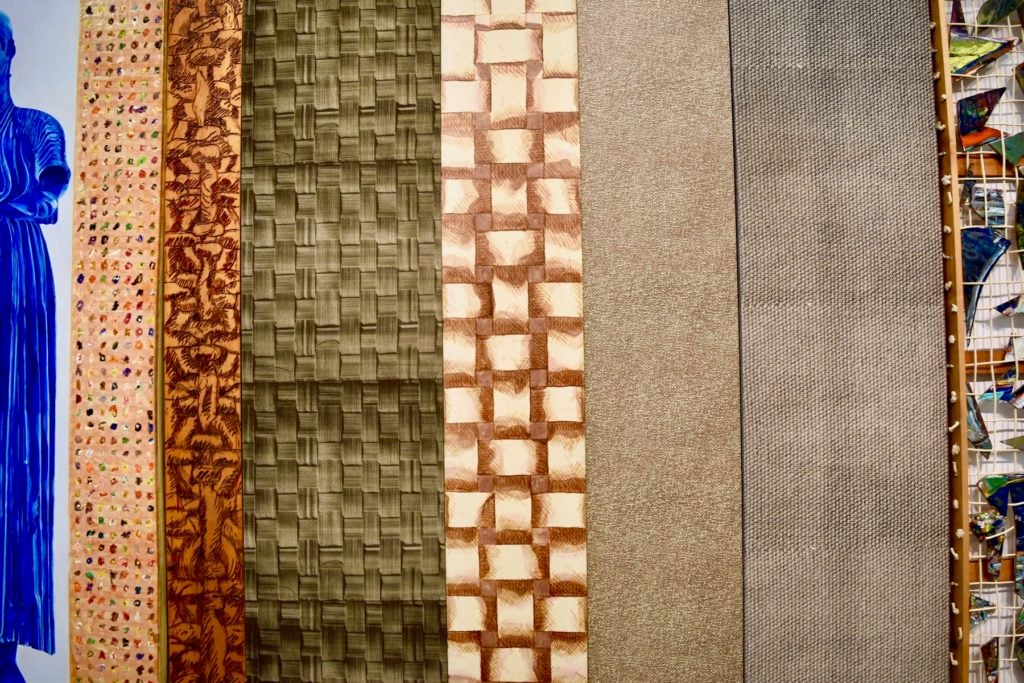
Detail of Joe Zucker, 100-Foot-Long-Piece (1968-69) at Marlborough. Image: Ben Davis.
And so the work channels the chaos of different abstract patterns and textures you run into in grimy everyday New York. It looks, from afar, like a collection of fabric swatches. Up close, it sort of is. Some panels show off cheap fabrics stretched out for consideration on their own, as deadpan examples of found abstract art. Other panels feature photographic silkscreens of various textile patterns, or weave patterns painted in sepia tones or burned into wood, the result being that at each step you have to think anew, a little, about the thing in front of you as an image.
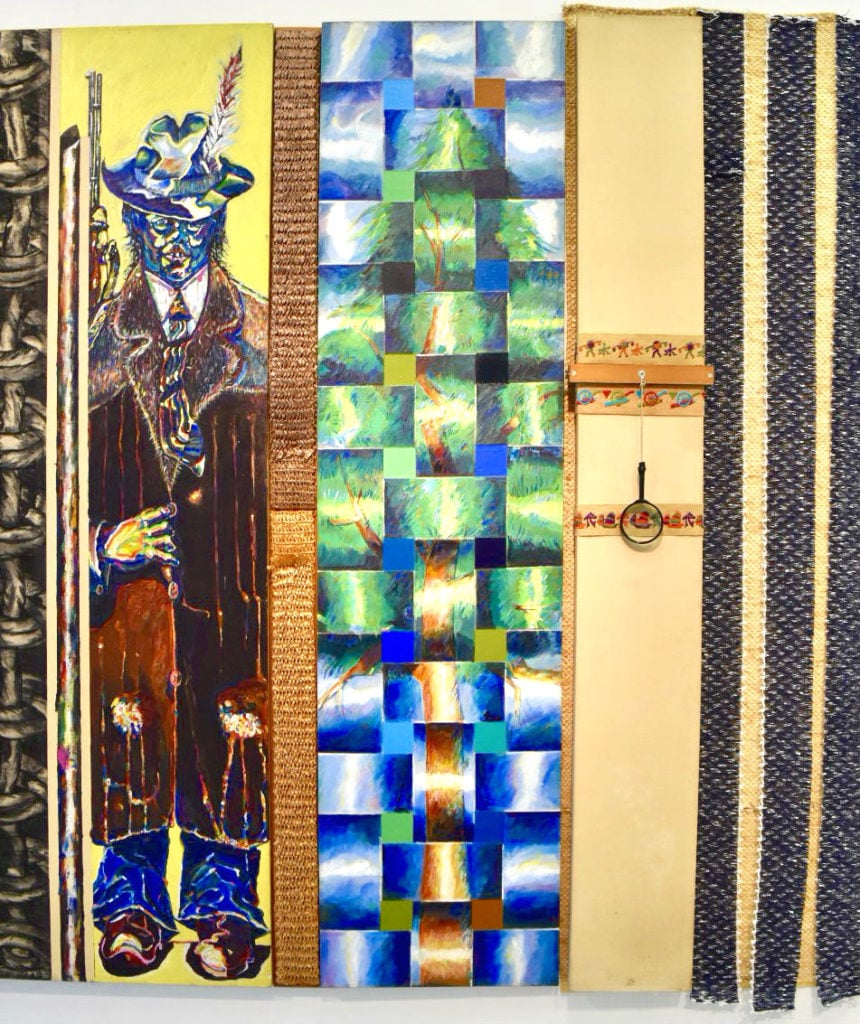
Detail of Joe Zucker, 100-Foot-Long-Piece (1968-69) at Marlborough. Image: Ben Davis.
Several of the panels render images that are made up from strips in that over-under lawn-chair weave style. One, for instance, features a cheerfully painted tree rendered as if the image were woven together, though Zucker seems also to have painted it as if parts of it were braided in wrong. The effect is, literally, puzzling.
Zucker recalls seeing Gerhard Richter’s first gallery show the US, in 1973, and a friend comparing the German painter’s deliberately eclectic work to his own “non-style.” That reflects where his painting falls in history, but there’s a clear difference: Richter’s shifts between edgy abstraction and icy photorealism have always been read as a kind of Olympian negation of the idea that you had to have a “signature style.”
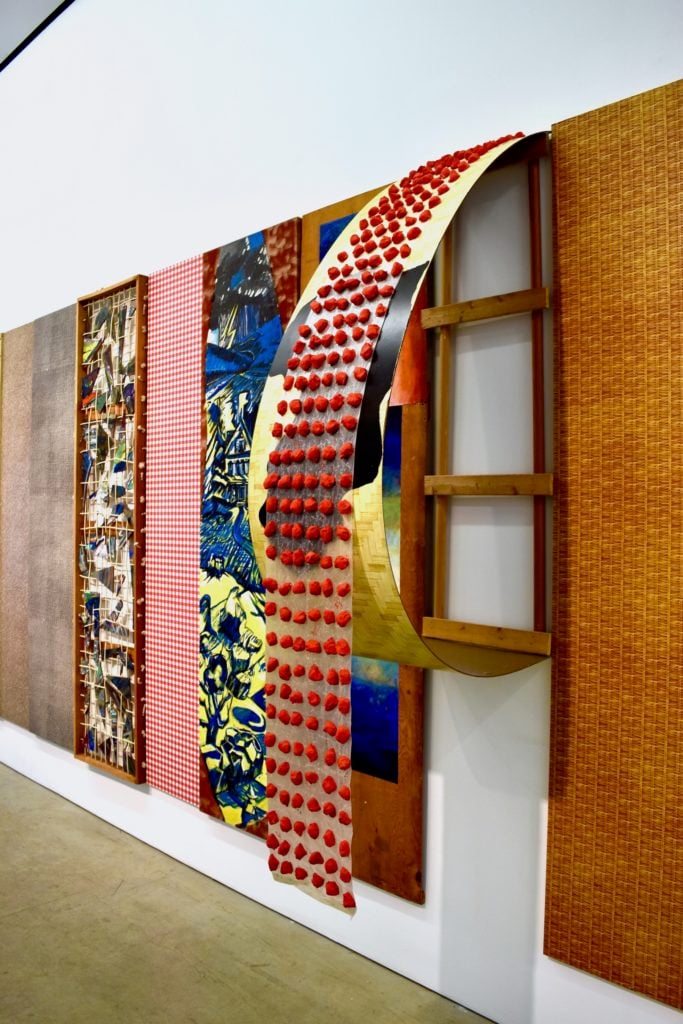
Detail of Joe Zucker, 100-Foot-Long-Piece (1968-69) at Marlborough. Image: Ben Davis.
By contrast, throughout the many shifts in Zucker’s 100-Foot-Long Piece, a consistent artistic personality actually does shine through: scrappy, deliberately off, wryly bemused. Whether in the abstract or in the figurative panels, there’s a kind of search for deskilled rawness that ties it all together.
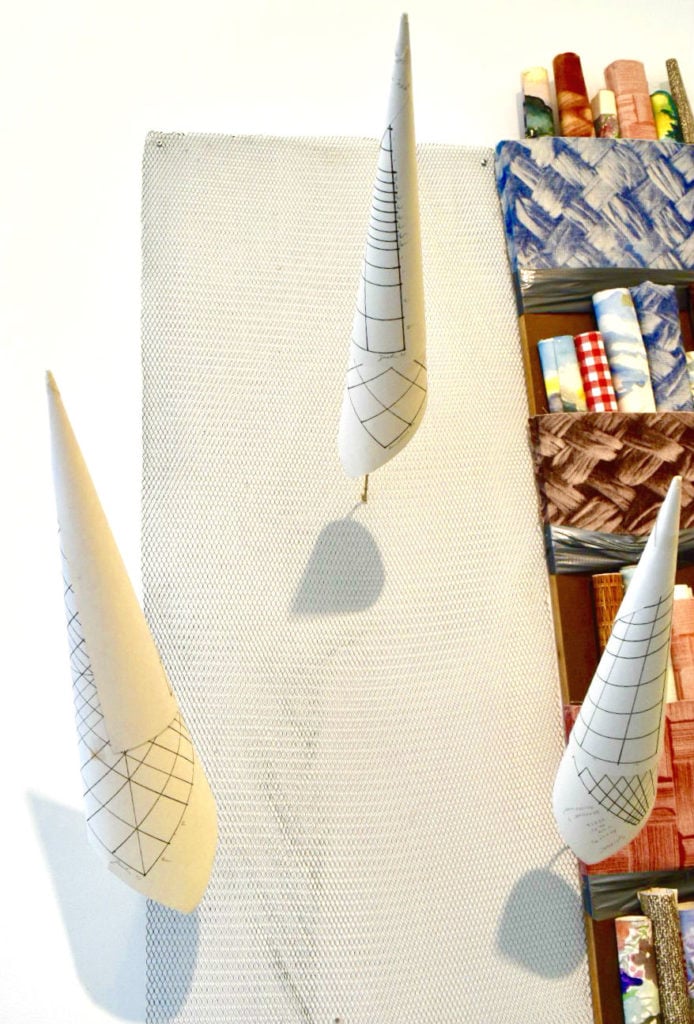
Detail of Joe Zucker, 100-Foot-Long-Piece (1968-69) at Marlborough. Image: Ben Davis.
It’s not just an exercise in random styles juxtaposed; there’s a kind of a plan to the thing. In fact, if you approach the painting from the left, the first panel actually references plotting an image: It features large cones of paper sticking off a wire mesh panel like horns, seemingly made from rolled-up drawings of the kind of grids used to plot a perspective drawing. This is followed by another panel, which features a library of little pouches, each stuffed with a different roll of patterned fabric—a funny statement about the way the artist has structured the painting overall, as one big pattern made of different patterns.
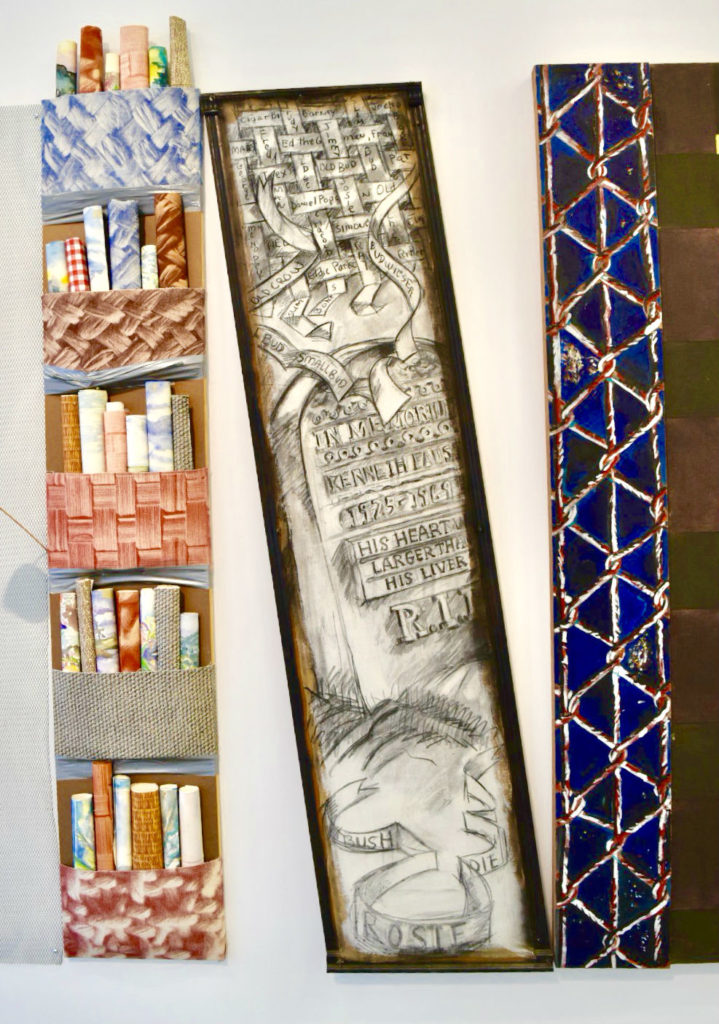
Detail of Joe Zucker, 100-Foot-Long-Piece (1968-69) at Marlborough. Image: Ben Davis.
The third panel from the right has scrawled, in smudgy charcoal, the image of a tombstone (it’s unique in that it is also leaned diagonally between its abutting panels—like a tombstone). I learned from the catalogue that it is a salute to the owner of a favorite bar of Zucker’s in Chicago, where he went to school. The tombstone has the affectionate epitaph, “His Heart Was Larger Than His Liver.” Above it, a series of ribbons features the nicknames of various bar regulars.
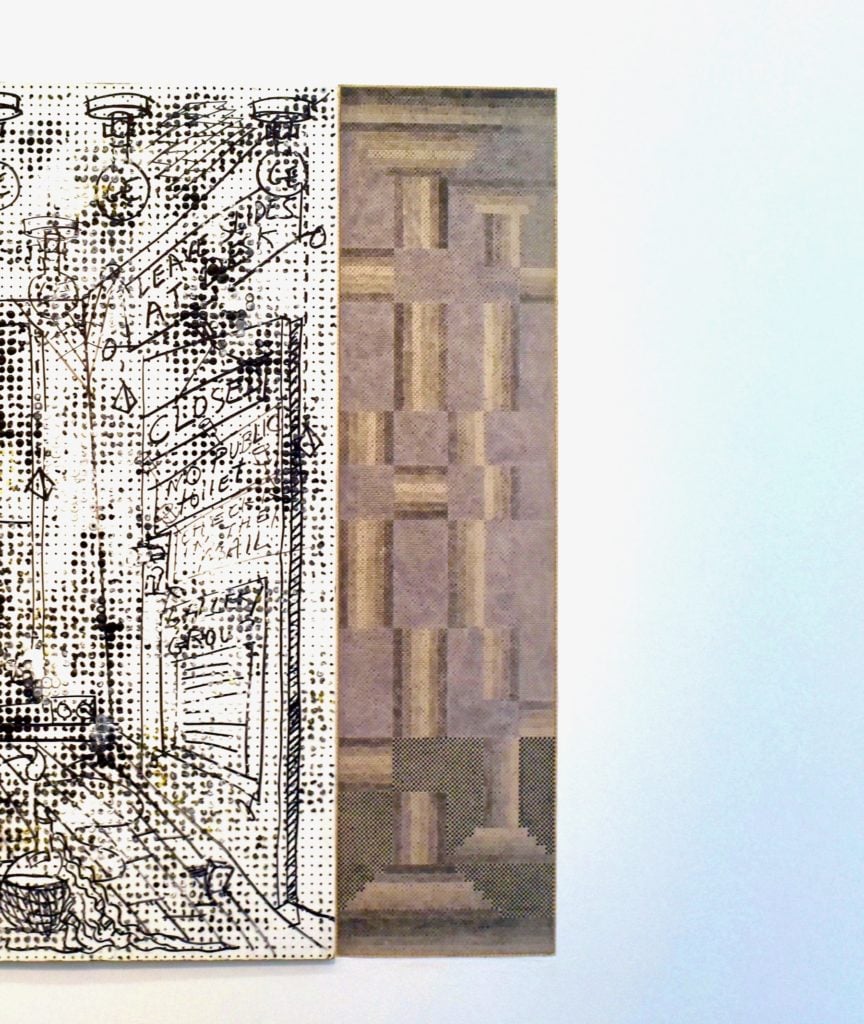
Detail of Joe Zucker, 100-Foot-Long-Piece (1968-69) at Marlborough. Image: Ben Davis.
Pass, now, all the way to the right extreme of the painting. The final “panel” is actually implanted directly into the surface of the wall itself, a work made from tightly gridded, incised gypsum board. In different tones of gray it creates a pattern evoking pixelated fragments of Ionic columns (I know that because Zucker has returned to this combination of material and subject).
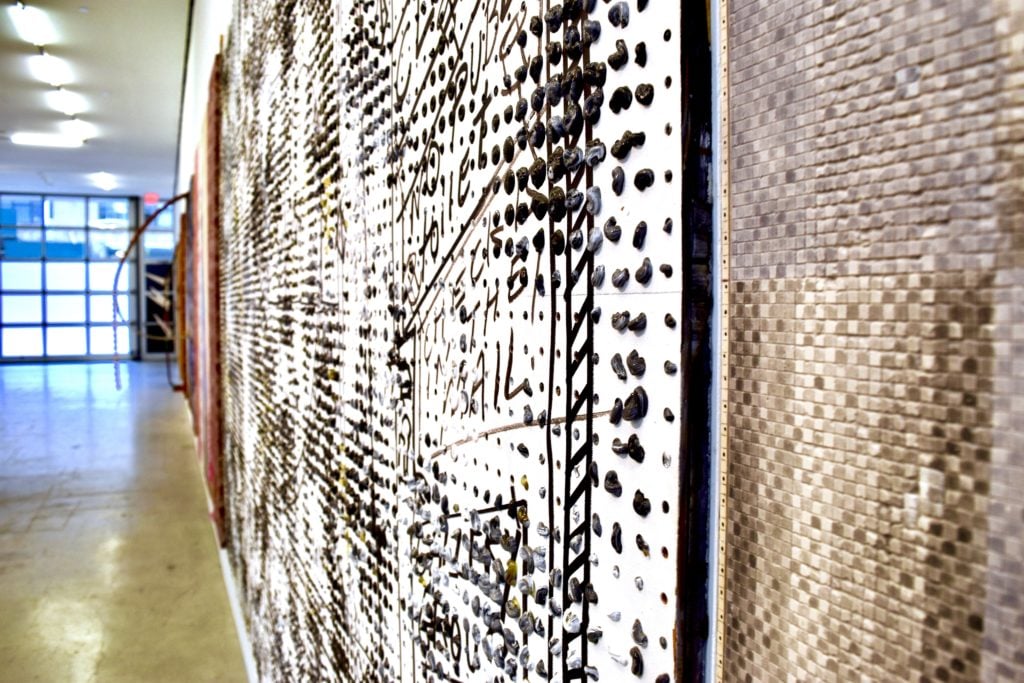
Detail of Joe Zucker, 100-Foot-Long-Piece (1968-69) at Marlborough. Image: Ben Davis.
Compare the two sides. The first panel on the left, with the cones, makes an obscure joke about perspective painting, rolling up the gridded system of lines used to create the illusion of receding space in order to make actual, physical cones. The gypsum panel on the right is a different riff on making the traditional stuff of painting literal, actually becoming part of the architecture. The former juts out at you; the latter burrows away from you. There’s a deep-in-his-head, you-see-it-if-you-squint kind of intellectual symmetry.
Located next in from the gypsum mosaic panel there is a large panel—the largest in this work—featuring a perforated white board and the immense, crudely drawn figure of a dead rat, belly up, near a can marked “RAID.” The setting seems to be an empty, squalid room with lots of bare, hanging light bulbs. Black paint pushed through holes in the board strongly evokes accumulated rat pellets.
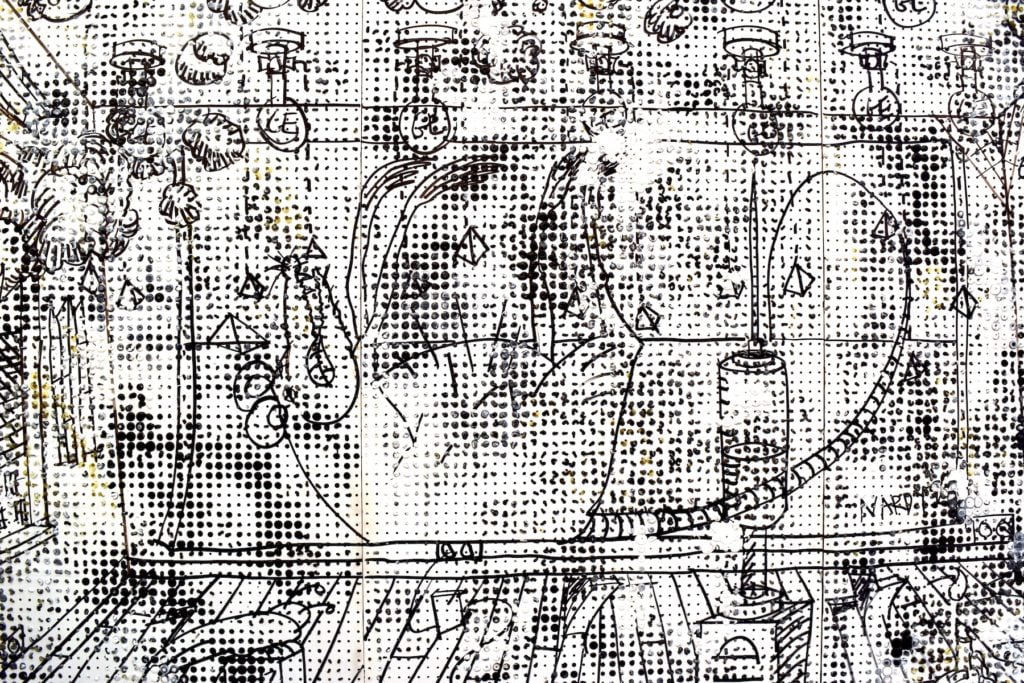
Detail of Joe Zucker, 100-Foot-Long-Piece (1968-69) at Marlborough. Image: Ben Davis.
Once again, if you think back to the first panels on the left, there’s a kind of symmetry: like the tombstone image, the rat image suggest thoughts of death. Both make a case through their darkly cartoonish sensibility that the low-ness of materials and deliberate crudeness of Zucker’s style is an analogue for a sense of down-and-out worldliness that he wants to evoke.
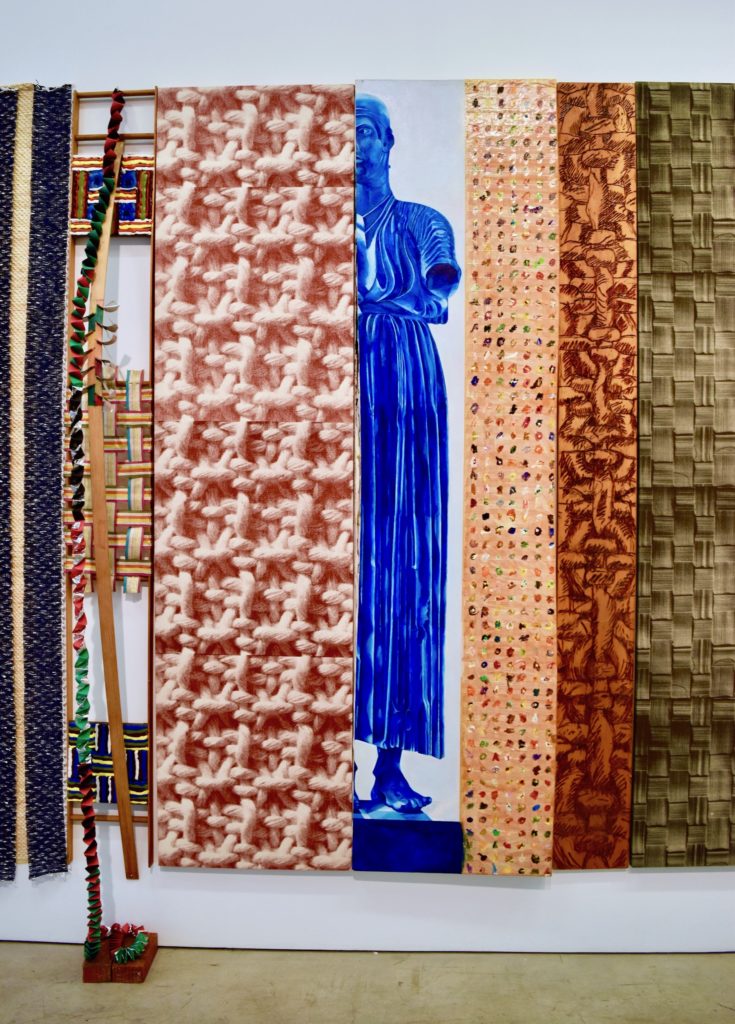
Detail of Joe Zucker, 100-Foot-Long-Piece (1968-69) at Marlborough. Image: Ben Davis.
This painting is not all dive bars and dead rats, though. Over the course of 100-Foot-Long Piece, there are more elevated images. There’s a figure that I gather is meant to be Billy the Kid (at top), the Old West outlaw, painted at a time when Western potboilers were still very much a part of pop culture but also on the decline. There’s a full-length image of the Charioteer of Delphi, a marker of classically high-culture ambition. And there’s an image of a rocket blasting off, a supreme symbol of technological potential in 1968-69, the time of the moon landing.
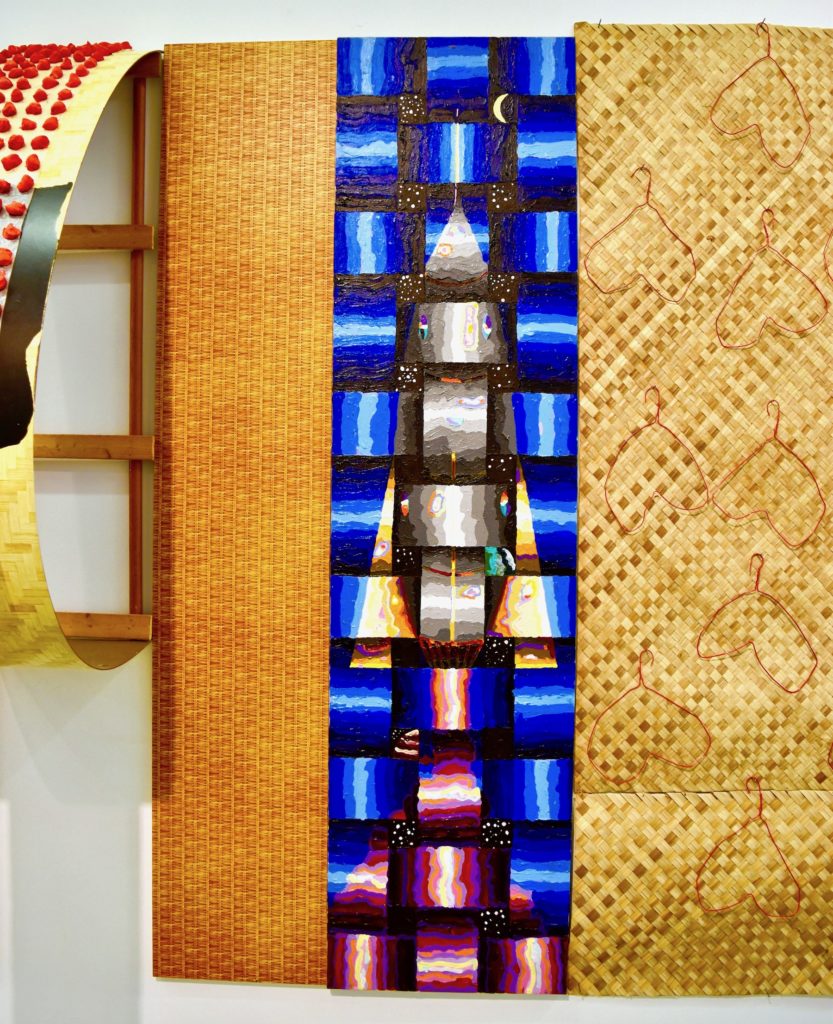
Detail of Joe Zucker, 100-Foot-Long-Piece (1968-69) at Marlborough. Image: Ben Davis.
But Billy the Kid is painted in a garish expressionist style and given a fur coat, a messy tie, and a feathered hat, making him look ridiculous. The Charioteer is rendered all in cyanotype blues, and is sliced vertically down the middle to make it a fragment. And the rocket is painted in that chair-weave style, giving the mighty Space Age symbol the appearance of a bedspread design, frozen and miniaturized rather than evoking grand dynamism. The message Zucker is going for is bringing the heroic down to earth.
Zucker’s personal name for this work, evidently, has been Tossed Salad. That title suggests parts gleefully thrown together, and in its bawdy double entendre, the sense of pleasurable aesthetic “wrongness” that he goes after.
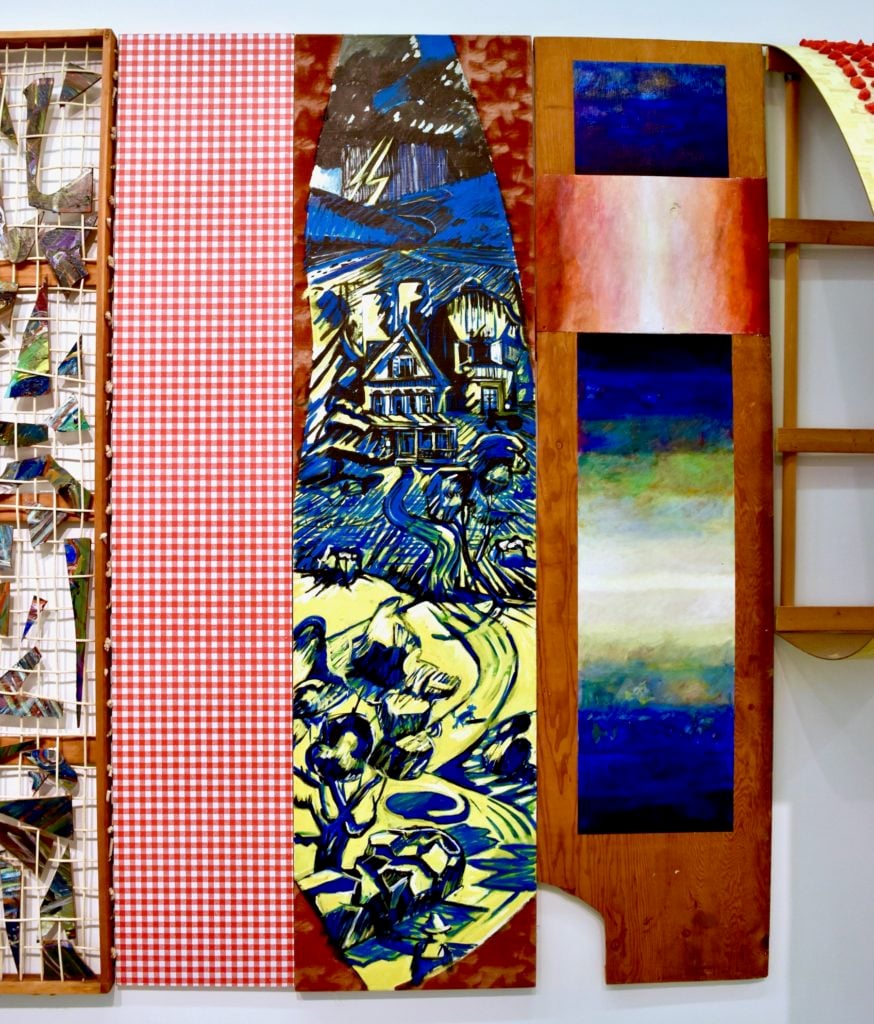
Detail of Joe Zucker, 100-Foot-Long-Piece (1968-69) at Marlborough. Image: Ben Davis.
But as a title, 100-Foot-Long Piece has its merits too: The tension between scale and sensibility is part of the warp and woof of this witty work. It’s a joking painting and the scale is part of the joke. It’s an anti-heroic work painted at a heroic scale.
Zucker’s opus grabs you in with the showstopping scale only to find that the pleasure it proposes—a low-fi wonkiness that takes joy from hitting a mark just a little on the near side of looking right as art—is actually a very intimate, personal, almost hermetic kind of pleasure. It’s a manifesto about art as a place for in-the-weeds personal references and small-scale material epiphanies. And that’s a very particular, cult kind of sensibility indeed—though maybe if you’ve made it this far through this review, you share it!
“Joe Zucker: 100-Foot-Long Piece, 1968-69” is on view at Marlborough, through October 5, 2019.